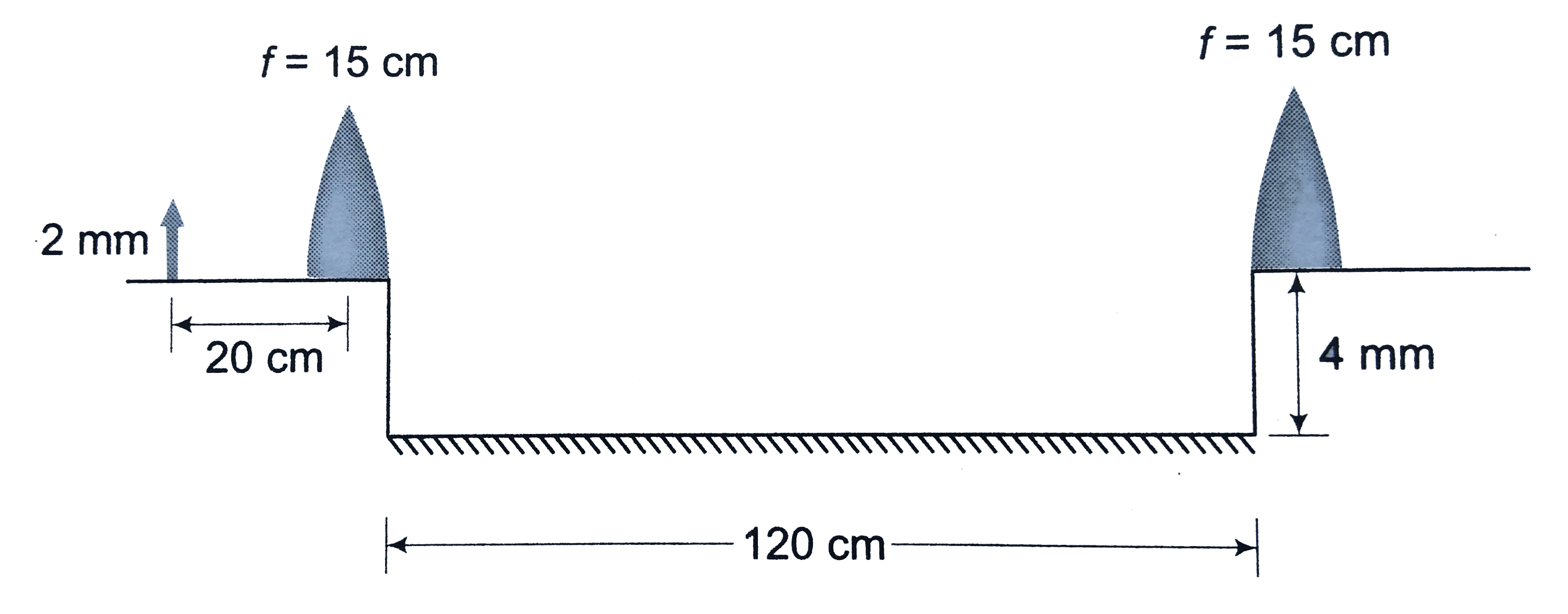In the figure shown, find the relative speed of a approach/ separation of the two final images formed after the light rays pass through the lens, at the moment when u = 30 cm . The speed of object = 4 cm/s . The two lens halves are placed symmetrically w.r.t. the moving object
_E01_157_Q01.png) Solution in Gujrati
Solution in Gujrati
The correct Answer is:(85)cm/s
I0=m=vu=ff+u,rel2dIdt=[−f0(f+u)2dudt]×2
=−40×1210×10×4×2=−85cm/sec
Topper's Solved these Questions
- GEOMETRICAL OPTICSBOOK - ALLEN CHAPTER - GEOMETRICAL OPTICSEXERCISE - EXERCISE-05 (A)
35 Videos
- GEOMETRICAL OPTICSBOOK - ALLEN CHAPTER - GEOMETRICAL OPTICSEXERCISE - EXERCISE-05 (B)
35 Videos
- GEOMETRICAL OPTICSBOOK - ALLEN CHAPTER - GEOMETRICAL OPTICSEXERCISE - EXERCISE-04[A]
23 Videos
- CURRENT ELECTRICITYBOOK - ALLEN CHAPTER - CURRENT ELECTRICITYEXERCISE - EX.II
66 Videos
- GRAVITATIONBOOK - ALLEN CHAPTER - GRAVITATIONEXERCISE - EXERCISE 4
9 Videos
Similar Questions
If two mirrors are kept at 60∘ to each other, then the number of images formed by them is ......
View SolutionA concave mirror is placed on a horizontal table, with its axis directed vertically upwards. Let O be the pole of the mirror and C its centre of curvature. A point object is placed at C. It has a real image, also located at C. If the mirror is now filled with water, the image will be.
View SolutionA plane mirror of circular shape with radius r=20cm is fixed to the ceiling .A bulb is to be placed on the axis of the mirror.A circular area of radius R=1m on the floor is to be illuminated after reflection of light from the mirror. The height of the room is 3m What is maximum distance from the center of the mirror and the bulb so that the required area is illuminated?
View SolutionIn the Bohr's model of hy drogen atom, the electron moves around the nucleus in a circular orbit of radius 5×10−11m. Its time period is 1.5×10−16s. The current associated with the electron motion is:-
View SolutionAssertion : The difference in the value of acceleration due to gravity at pole and equator is proportional to square of angular velocity of earth.
Reason : the value of acceleration due to gravity is minimum at the equator and maximum at the pole.
View SolutionAn equi-convex lens of mu=1.5 and R=20 cm is cut into two equal parts along its axis. Two parts are then separated by a distance of 120 cm (as shown in figure). An object of height 3 mm is placed at a distance of 30 cm to the left of first half lens. The final image will form at
View SolutionA convex lens of focal length 15cm is split into two halves and the two halves are placed at a separation of 120cm. Between, the two halves of convex lens a plane mirror is placed horizontal and at a distance of 4mm below the principal axis of the lens halves. An object of length 2mm is placed at a distance of 20cm from one half lens as shown in figure.

Find the position and size of the final image.
Trace the path of rays forming the image.
View SolutionA convex lens forms an image of an object on a screen 30 cm from the lens. When the lens is moved 90 cm towards the object, then the image is again formed on the screen. Then, the focal length of the lens is
View SolutionWhen an object is placed at a distance of 36 cm from a convex lens, an image of the same size as the object is formed. What will be the nature of image formed when the object is formed. What will be the nature of image formed when the object is placed at a distance of: a) 10 cm from the lens? b) 20 cm from the lens?
View SolutionA lens forms a real image 3 cm high of an object 1 cm high. If the separation of object and image is 15 cm, find the focal length of the lens.
View SolutionDraw a labelled ray diagram for the formation of image by a convex lens of focal length 15 cm when the object is placed at a distance of 25 cm from the lens. Determine the size of the image formed, if size of the object is 4 cm.
View Solutionएक उत्तल लेंस (convex lens) से 30 cm की दूरी पर रखी एक वस्तु का वास्तविक प्रतिबिम्ब (real image) लेंस से 20 cm की दूरी पर बनता है लेंस की फोकस-दूरी (focal lenght) निकाले
View Solutionएक अवतल लेंस से 30 cm की दूरी पर रखी एक वस्तु का प्रतिबिम्ब लेंस से 20 cm की दूरी पर बनता है लेंस की फोकस-दूरी निकाले
View SolutionA screen is placed 90 cm away from a luminous object. The image of the object on the screen is formed by a convex lens at two different positions separated by 30 cm. what is the focal length of the lens?
View SolutionA convex lens of focal length 15 cm is split into two halves and the two halves are placed at a separation of 120 cm. Between the two halves of convex lens a plane mirror is placed horizontally and at a distance of 4 mm below the principal axis of the lens halves. An object AB of length 2 mm is placed at a distance of 20 cm from one half lens as shown in.figure. The final image of the point A is formed at a distance ofn3mm from the principle axis. Determine the value of n

View SolutionDraw a labelled ray diagram for the formation of image by a convex lens of focal length 15 cm when the object is placed at a distance of 25 cm from the lens. Determine the size of the image formed, if size of the object is 4 cm.
View Solution
